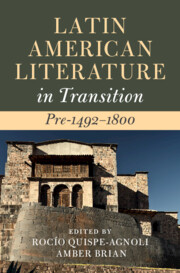Book contents
- Latin American Literature in Transition Pre-1492–1800
- Latin American Literature in Transition
- Latin American Literature in Transition Pre-1492–1800
- Copyright page
- Dedication
- Contents
- Figures
- Contributors
- Acknowledgments
- Introduction Dwelling in Transitions
- Part I Land, Space, Territory
- Part II Body
- Part III Belief Systems
- Part IV Literacies
- Part V Languages
- Chapter 18 Technologies of Communication in Transition: Indigenous Orality and Writing in Colonial Mexico
- Chapter 19 A Baroque Arte: Horacio Carochi and the Tradition of Nahuatl Grammars
- Chapter 20 Acquiring a Voice: The Plebeians Speak in Early Colonial Río de la Plata
- Chapter 21 Knowledge in Transition: Rethinking the Science of Sameness in Sor Juana Inés de la Cruz’s New Spain
- Part VI Identities
- Index
- References
Chapter 21 - Knowledge in Transition: Rethinking the Science of Sameness in Sor Juana Inés de la Cruz’s New Spain
from Part V - Languages
Published online by Cambridge University Press: 25 November 2022
- Latin American Literature in Transition Pre-1492–1800
- Latin American Literature in Transition
- Latin American Literature in Transition Pre-1492–1800
- Copyright page
- Dedication
- Contents
- Figures
- Contributors
- Acknowledgments
- Introduction Dwelling in Transitions
- Part I Land, Space, Territory
- Part II Body
- Part III Belief Systems
- Part IV Literacies
- Part V Languages
- Chapter 18 Technologies of Communication in Transition: Indigenous Orality and Writing in Colonial Mexico
- Chapter 19 A Baroque Arte: Horacio Carochi and the Tradition of Nahuatl Grammars
- Chapter 20 Acquiring a Voice: The Plebeians Speak in Early Colonial Río de la Plata
- Chapter 21 Knowledge in Transition: Rethinking the Science of Sameness in Sor Juana Inés de la Cruz’s New Spain
- Part VI Identities
- Index
- References
Summary
When Sor Juana Inés de la Cruz (1648?-1695) famously described the natural secrets of cooking, she invoked some of the foundational terms of colonial science and society, from Aristotelian paradigms to Columbian acts of claiming. Scholars have long noted the importance of scientific knowledge to Sor Juana and underscore her engagement with Indigenous cultures, languages, and traditions. But few scholars have examined the intersection of Indigenous knowledge and scientific writing in Sor Juana’s ouvre. This chapter, grounded in a reading of classical natural philosophy, as it was expressed in Sor Juana’s Respuesta (1695), represents an effort to bring these research areas into dialogue. By juxtaposing Mayan-language documents from colonial Yucatán with Sor Juana’s masterful defense of knowledge in central New Spain, this chapter analyzes how Indigenous ways of knowing may have shaped one of the most important treatises on knowledge in colonial Mexico, thus suggesting. ways in which colonial letters both mark and help to promote critical transitions in the meaning of knowledge, epistemological categories, and the nature of knowledge production itself.
Keywords
- Type
- Chapter
- Information
- Latin American Literature in Transition Pre-1492–1800 , pp. 315 - 330Publisher: Cambridge University PressPrint publication year: 2022

